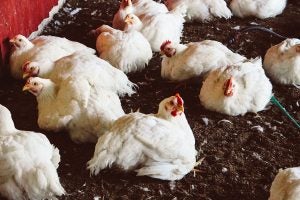Organic overhauls have been a long time coming. Among the Strengthening Organic Enforcement rule released earlier this year, the U.S. Department of Agriculture has previewed today’s Organic Livestock and Poultry Standards final rule, with a heavy focus on organic producers using better nutrition and medical practices to minimize pain, stress and suffering in their animals.
The new rule hopes to establish “clear, strong, and consistent standards for organic livestock and poultry production,” while providing greater consumer transparency.
The flagship requirement says that organic producers treat animals with all necessary treatments, even if they lose out on their organic status. Currently, organic farming is based on the principles that an animal that is allowed to exhibit natural behavior and feeds with the hope that this will lead to better coping with infections. While there isn’t specific data referenced in the USDA’s changes, it seems clear that the new steps are being taken because of shortfalls in the current organic approach to animal welfare.
Despite a strong public perception of what organic labels mean, a number of myths surround organic production. And, the USDA found through 40,000 public comments a need to more clearly outline and enforce standards for animal welfare practices in organic production.

There are six primary areas in which the OLPS aims to provide greater uniformity and promote animal well-being for livestock and poultry:
- Preventative health care practices: Producers must maintain preventive health care practices that include sufficient nutrition and comprehensive parasite prevention plans. Animals must be treated with allowed medicines to minimize pain, stress, and suffering. All necessary treatment must be administered, even if the animal loses its organic status.
- Physical alterations and euthanasia: Physical alterations are permitted only for identification purposes or the safety of the animals, and certain alterations are prohibited altogether. Alterations must be performed at a young age for the species in a manner to minimize the animal’s pain and stress. Humane euthanasia may only be used if treatment is not an option.
- Transport, handling, and slaughter: Operations must describe how organic management and animal welfare will be maintained for transport that exceeds eight hours. Animals must be fit for transport. The mode of transport must be seasonally appropriate to protect livestock from cold or heat. Operations must adhere to USDA humane slaughter standards.
- Poultry stocking densities: The rule sets specific requirements for indoor and outdoor stocking densities to align with advisory board recommendations, third-party animal welfare standards, and public comments from organic stakeholders.
- Indoor and outdoor living conditions: Shelters must have sufficient space for livestock to lie down, stand up, turn around, fully stretch their limbs or wings, and express natural behaviors, such as rooting in pigs and scratching in chickens. Bedding areas must be sufficiently large and comfortable to keep livestock hygienic (for the species), dry, and free of lesions.
- Outdoor space requirements: OLPS sets minimum outdoor space requirements for organic poultry and requires ready access to the outdoors. Outdoor areas must be at least 75 percent soil and include vegetation to the degree possible.
In partnership with USDA-accredited certifiers, USDA’s National Organic Program will oversee the implementation of and enforce compliance with these new, more consistent standards to support the growth of the organic market.
“USDA is creating a fairer, more competitive, and transparent food system. This organic poultry and livestock standard establishes clear and strong standards that will increase the consistency of animal welfare practices in organic production and in how these practices are enforced,” said Agriculture Secretary Tom Vilsack. “Competitive markets help deliver greater value to all producers, regardless of size.”
The final rule will be published in the Federal Register. A preview of the rule is available on the AMS website.
»Related: Farmer’s Daughter: How the USDA views organic food from Mexico


